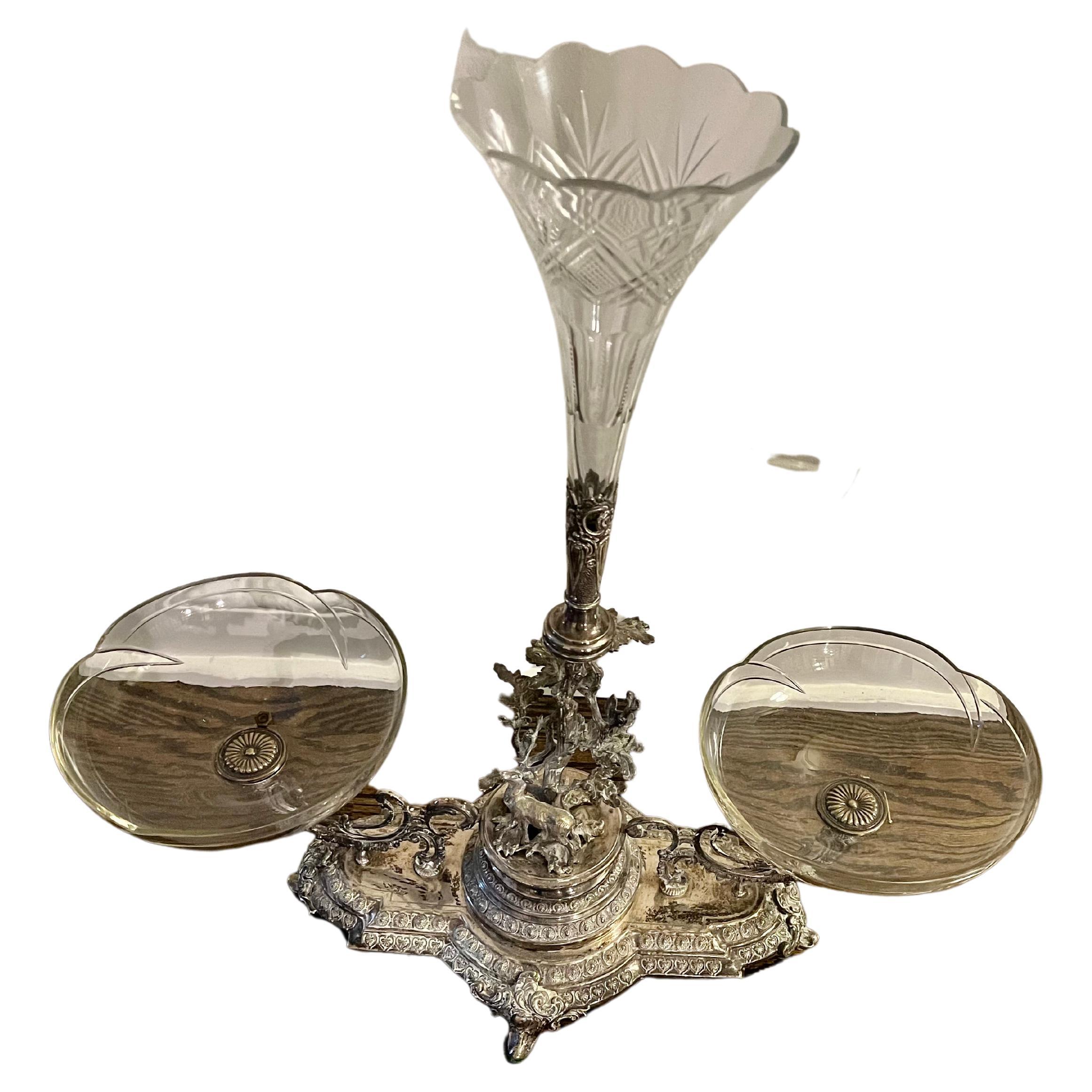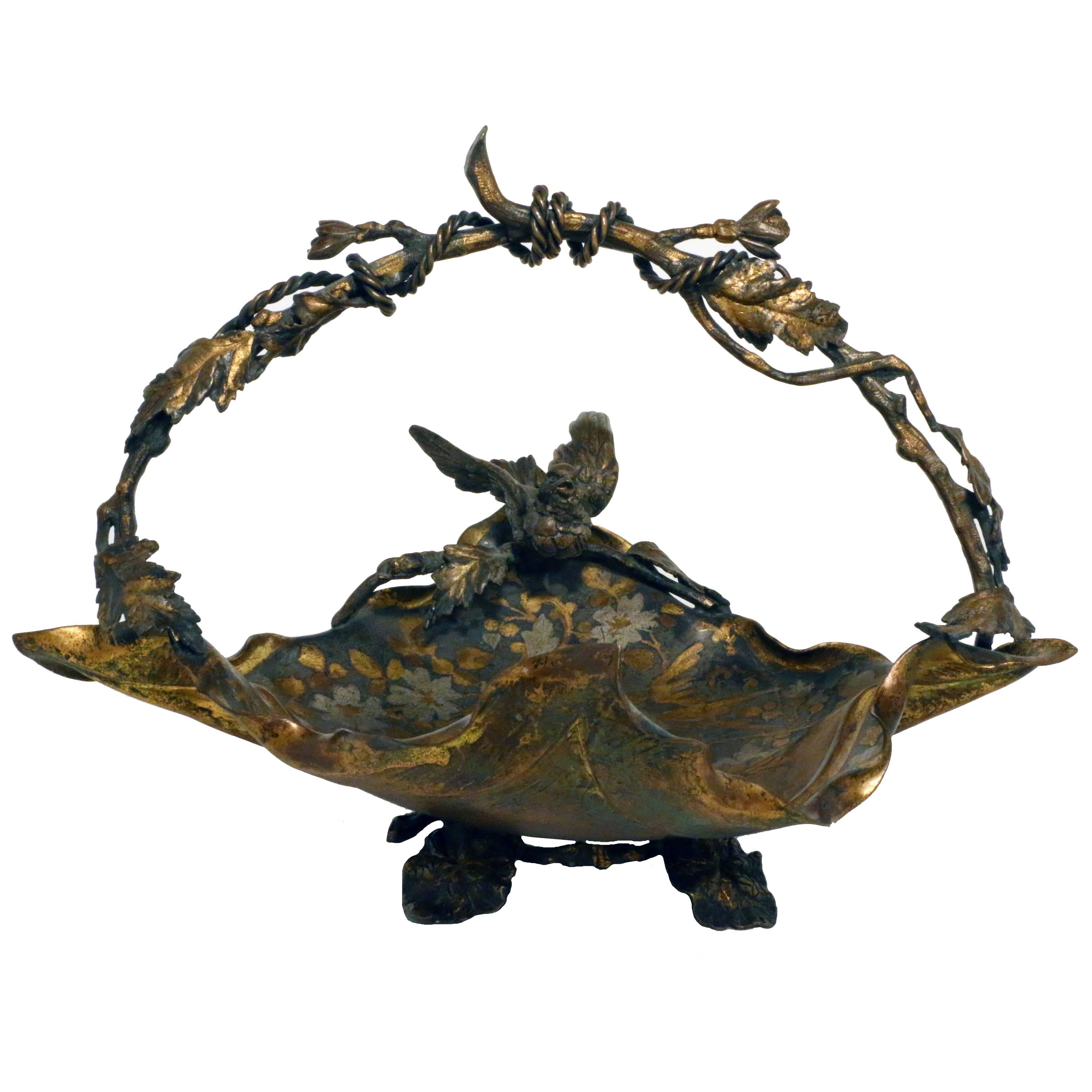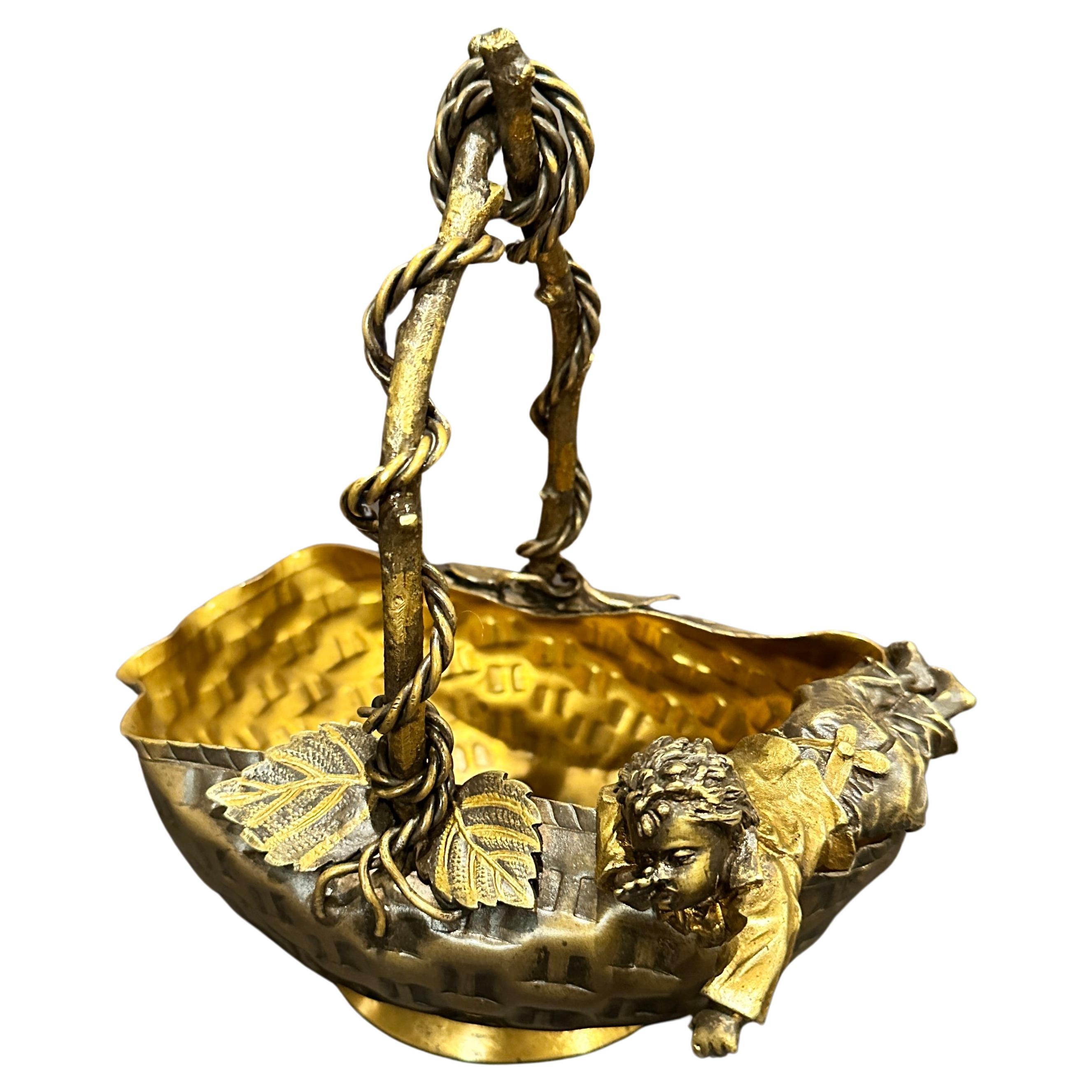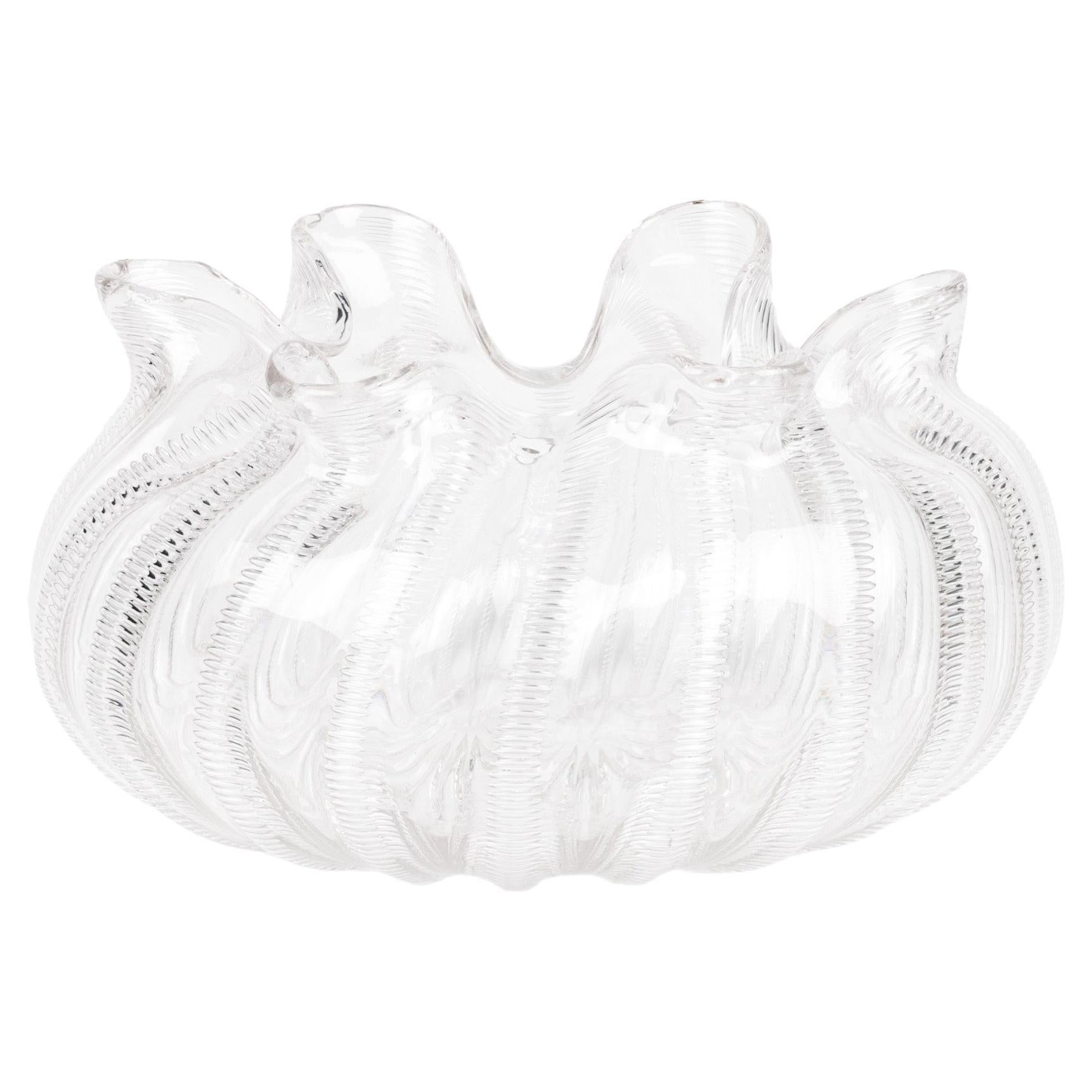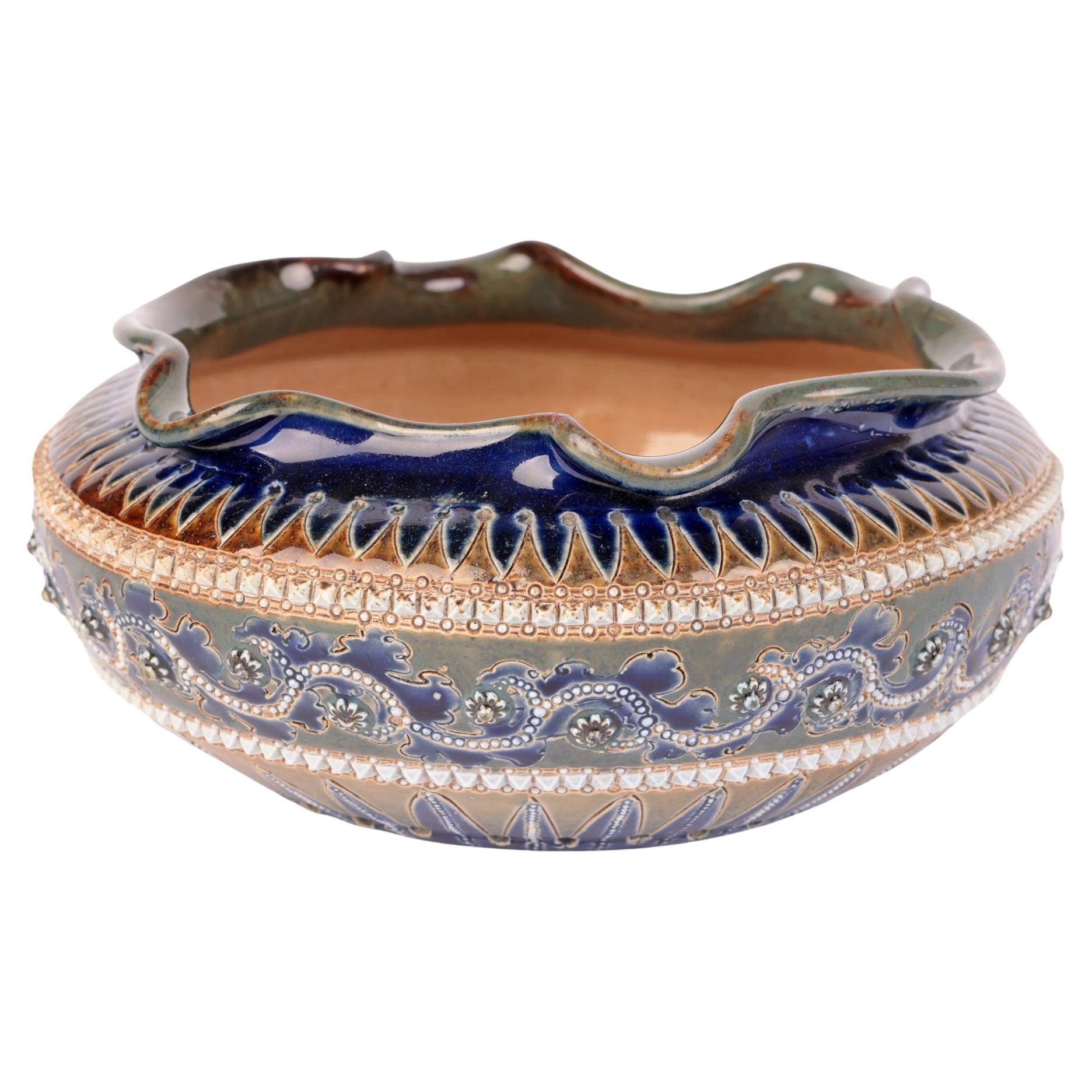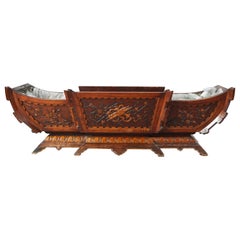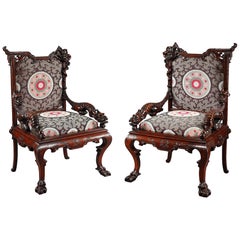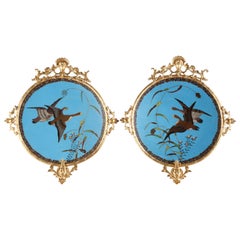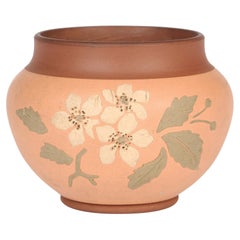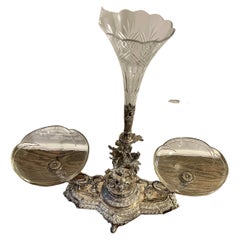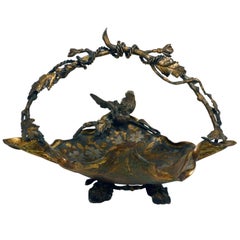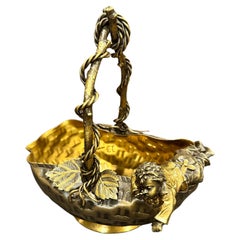Items Similar to Aesthetic Movement Enameled Plate Attributed to Elkington and A. Willms, c. 1875
Want more images or videos?
Request additional images or videos from the seller
1 of 6
Aesthetic Movement Enameled Plate Attributed to Elkington and A. Willms, c. 1875
About the Item
Important tray made in gilded bronze and “cloisonné” enamel attributed to Elkington and Willms. Ornamented with a centering polychrome enameled peacock plaque, made of very high standard quality, mounted on a gilt-bronze dish, decorated in relief with Japanese Nô theater masks.
The great Birmingham firm of Elkingtons, was largely the creation of George Richards Elkington (1800-1865), who worked from 1824 in Birmingham as a manufacturer of silver-mounted scent bottles. By 1829 the business had expanded sufficiently for a branch to have been established in London. In the late 1830s the Elkingtons began making experiments to apply the principles of electro-metallurgy to gilding and plating with silver and in 1840 the patent was at last taken out. Elkingtons owed their rise to a position amongst the most important silversmiths of the country to their exploitation of this new process and the two of the most famous designers then employed, both of them French, Albert Wilms (1827-1899) and Morel-Ladeuil (1820-1888), who helped to make Elkingtons’ reputation with their elaborate exhibition pieces.
Albert Willms was apprenticed as modeler and engraver to Klagman, Dieterle and Constant in Paris before working for Morel & Co. in London in 1848. On his return to Paris he was employed by the great Parisian silversmiths including Christofle and Froment-Meurice, for whom he designed pieces to be presented at the 1855 Universal Exhibition in Paris. It was during this period that he joined the firm of Elkington in London as head decorator. Elkington was soon to become one of the first to produce refined pieces in “champlevé” enamel in the Chinese and Japanese styles, which were presented with great success at the London Universal Exhibition in 1862 (see Masterpieces of Industrial Art & Sculpture at the International Exhibition 1862, J.B. Waring, London, 1863, III, pl. 211). Willms’ “champlevé” enamels could not be compared, however, with the delicate “cloisonné” enamels exhibited by Japan at the Universal Exhibition in Paris in 1867. This explains why Elkington adapted the ancient Japanese technique to produce pieces according to European taste and custom. Followings the 1867 Exhibition all the major European artists rivaled in ingenuity for the 1873 Universal Exhibition in Vienna. In London Albert Willms presented his luxurious vases and cups in “cloisonné” enamel for Elkington (see Illustrations of Art Manufacturers in the Precious Metals exhibited by Elkington & Co., Inventors, Patentees and Manufactures of electroplate, 1873), whilst in Paris, Ferdinand Thesmar (1843-1912) produced in the workshops of Ferdinand Barbedienne (1810-1892) a tray decorated with a golden pheasant in “cloisonné” enamel on copper and Emile-Auguste Reiber (1826-1893) designed for the Christofle firm, a large clock with matching candelabras in the Japanese style (Musée d’Orsay, Paris, Inv. O.A.O. 1360-1361) with “cloisonné” enamels executed by Antoine Tard. Albert Willms never the less became a specialist of “cloisonné” enamel on gilt metal between 1870 and 1876. The Universal Exhibitions where Elkington presented to the public his latest creations in the Japanese style, assured him a resounding success, as at the Philadelphia Exhibition in 1876 with an extensive set of vases and dishes in “cloisonné” enamel (reproduced in Contributions to the Centennial and International Exhibition at Philadelphia, 1876, London, 1876). Referring to his enamels the critics said “They surpass by far modern Chinese and Japanese works and approach the exquisite beauty of ancient Japanese pieces”.
- Attributed to:W. Albert Willms (Designer)Elkington & Co. (Manufacturer)
- Dimensions:Height: 1.19 in (3 cm)Diameter: 20.87 in (53 cm)
- Style:Aesthetic Movement (In the Style Of)
- Materials and Techniques:
- Place of Origin:
- Period:
- Date of Manufacture:circa 1875
- Condition:Wear consistent with age and use.
- Seller Location:PARIS, FR
- Reference Number:Seller: 1048/51stDibs: LU3860313525992
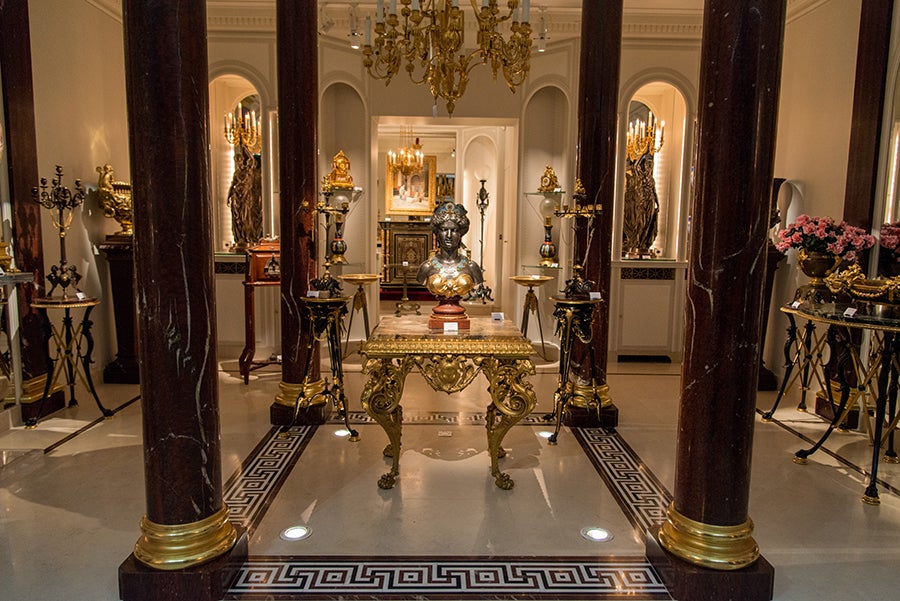
About the Seller
4.9
Gold Seller
Premium sellers maintaining a 4.3+ rating and 24-hour response times
Established in 1997
1stDibs seller since 2018
85 sales on 1stDibs
Typical response time: <1 hour
Associations
International Confederation of Art and Antique Dealers' Associations
- ShippingRetrieving quote...Shipping from: PARIS, France
- Return Policy
Authenticity Guarantee
In the unlikely event there’s an issue with an item’s authenticity, contact us within 1 year for a full refund. DetailsMoney-Back Guarantee
If your item is not as described, is damaged in transit, or does not arrive, contact us within 7 days for a full refund. Details24-Hour Cancellation
You have a 24-hour grace period in which to reconsider your purchase, with no questions asked.Vetted Professional Sellers
Our world-class sellers must adhere to strict standards for service and quality, maintaining the integrity of our listings.Price-Match Guarantee
If you find that a seller listed the same item for a lower price elsewhere, we’ll match it.Trusted Global Delivery
Our best-in-class carrier network provides specialized shipping options worldwide, including custom delivery.More From This Seller
View AllAesthetic Movement Jardiniere Attributed to G .Viardot, France, circa 1880
By Gabriel Viardot
Located in PARIS, FR
A large Japanese style boat-shaped jardiniere attributed to G. Viardot, made in carved wood, ornated with panels decorated with Japanese blossoming cherry tree branches and a trophy ...
Category
Antique 1880s French Aesthetic Movement Planters, Cachepots and Jardinières
Materials
Wood
Pair of Aesthetic Movement Armchairs Attributed to G.Viardot, France, Circa 1880
By Gabriel Viardot
Located in PARIS, FR
These armchairs made of tinted wood are to be linked to another pair of armchairs executed by Gabriel Viardot, and now exhibited at the Decorative Arts Museum in Paris (Inv. 2006.105.1.2). They present a similar asymmetric design and an equal carving quality including the winding dragon on the back. (see picture attached)
Gabriel Viardot career began as a wood carver and he produced small furniture, sculpturally carved with naturalistic motifs and animals. In the 1855 Exposition Universelle in Paris, his finely sculpted objects were well received. However, with the increasing importation of similarly produced Swiss and German articles, he found less opportunity for these and decided to innovate. G. Viardot succeeded to his father’s business in 1861 installed rue Rambuteau in Paris, circa 1870 he turned to the idea of producing “Meubles genre Chinois et Japonais”. The taste in Europe for exotic furniture...
Category
Antique 1880s French Aesthetic Movement Armchairs
Materials
Fabric, Wood
Fine Pair of 'Cloisonne' Enamel Dishes Attributed to A. Giroux, France, c. 1880
By Alphonse Giroux et Cie
Located in PARIS, FR
Beautiful pair of polychrome “cloisonné” enamel display dishes attributed to A. Giroux, decorated with birds flying over rushes and flowers on a sky blue background, bordered with a stylized foliate motif frieze. Finely mounted with gilded bronze ornaments such bamboos, masks and scrolls.
Alphonse Giroux and company, famous curiosity and luxury goods shop was situated at No. 7 rue du Coq-Saint-Honoré and in business from the time of the Consulate until the end of the Second Empire. The company was founded by Francois-Simon-Alphonse and continued in 1838 by his two sons, Alphonse-Gustave (1810-1886) and André (1801-1879).
The father became a close associate of the royal family and specialized in the manufacture of refined items for gifts, winning a silver medal at the in 1834. Kings Louis XVIII and then Charles X were both supplied with gifts for “The Children of France” by Giroux. Making progressively small furniture, they were mentionned for the first time in 1837 in the class “cabinet...
Category
Antique 1880s French Decorative Dishes and Vide-Poche
Materials
Enamel, Bronze
$11,169 Sale Price / set
20% Off
Rare Aesthetic Movement Wall-Light Attributed to G. Viardot, France, Circa 1880
By Gabriel Viardot
Located in PARIS, FR
A large Japanese style four lights sconce attributed to G. Viardot, in shape of a dragon made in carved tinted wood, holding in its mouth a Japanese blossoming cherry tree branch, fr...
Category
Antique 1880s French Japonisme Wall Lights and Sconces
Materials
Wood
$20,476 Sale Price / item
21% Off
Pair of Aesthetic Movement Vases Attributed to Susse Frères, France, Circa 1880
By Susse Freres
Located in PARIS, FR
A very fine pair of Japanese style vases attributed to Susse Frères and made in two patina bronze. Each vase in form of a patinated bronze ovoid body...
Category
Antique 1880s French Japonisme Vases
Materials
Bronze
$1,489 Sale Price / set
20% Off
Planter and Decorative Dish Attributed to Samson & Cie, France, Circa 1880
By Samson & Cie
Located in PARIS, FR
Important porcelain planter and decorative dish attributed to Samson & Cie.
They are decorated with golden and red friezes of intertwined lotus, fruits and flower cups, fans and two...
Category
Antique 1880s French Planters, Cachepots and Jardinières
Materials
Porcelain
You May Also Like
Christopher Dresser Attributed Aesthetic Movement Terracotta Bowl
By Christopher Dresser
Located in Bishop's Stortford, Hertfordshire
A very stylish aesthetic movement terracotta bowl with slip applied floral designs in the manner of Watcombe and design attributed to Christopher Dresser dating from around 1880. Thi...
Category
Antique Late 19th Century English Aesthetic Movement Decorative Bowls
Materials
Terracotta
Mid Nineteenth Century Silver Plate Centerpiece by Elkington and Co.
By Elkington & Co.
Located in Winnetka, IL
Mid nineteenth century silver plate naturalistic centerpiece by Elkington and Co. depicting deer and flora.
Category
Antique Mid-19th Century English Aesthetic Movement Decorative Dishes an...
Materials
Silver Plate
$1,120 Sale Price
60% Off
Aesthetic Movement Tromp L'Oeil Basket
Located in Montreal, QC
An American Aesthetic Movement Basket, naturalistically modeled as a bird perched on a a leafy twig, above a shallow dish simulating cloth, decorated with gilt and silvered leaves an...
Category
Antique Late 19th Century French Aesthetic Movement Decorative Baskets
Materials
Bronze
$1,260 Sale Price
30% Off
French Aesthetic Movement Patinated Bronze Figural Bowl/Basket
Located in Norwood, NJ
French aesthetic movement patinated and gilt bronze figural center bowl/basket, third quarter 19th century, formed as a large stylized woven ...
Category
Antique Late 19th Century French Aesthetic Movement Decorative Baskets
Materials
Bronze
Stevens & Williams Aesthetic Movement Jewel Pattern Glass Bowl
By Stevens & Williams
Located in Bishop's Stortford, Hertfordshire
A fine quality aesthetic movement English glass bowl decorated in a Jewel pattern by renowned Stourbridge glass makers Stevens & Williams and dated 1886. The crystal glass bowl is of...
Category
Antique 1880s English Aesthetic Movement Decorative Bowls
Materials
Crystal
George Tinworth Doulton Lambeth Aesthetic Movement Pottery Bowl, 1879
By Doulton Lambeth
Located in Bishop's Stortford, Hertfordshire
A very fine and decorative Aesthetic Movement Doulton Lambeth early stoneware bowl decorated with scrolling seaweed and rosette designs by renowned artist George Tinworth and dated 1...
Category
Antique 1870s English Aesthetic Movement Decorative Bowls
Materials
Stoneware
Recently Viewed
View AllMore Ways To Browse
French Aesthetic Movement
J C Plates
Enamel On Metal Plates
Aesthetic Movement Bronze
Antique Enamel Bowls
Plates Chinese Enamel
Gold Plated Dishes
Champleve Plate
Enamel And Gold Bowls
Enamel Copper Plate
Enameled Copper Plate
Dishes Made In England
French Set Of Dishes
Japanese Enamel Plate
Chinese Dishes Sets
French Enamel On Copper
Antique Dishes From England
Antique European Dishes

